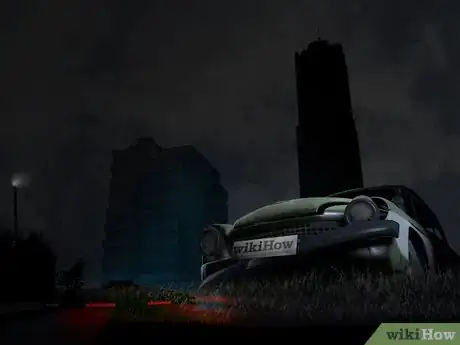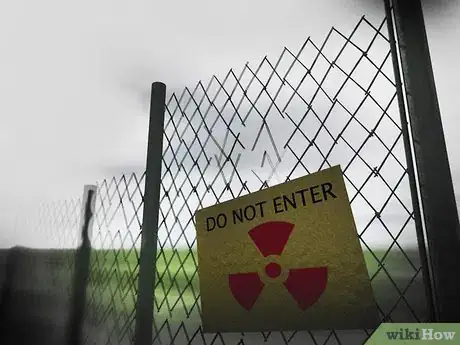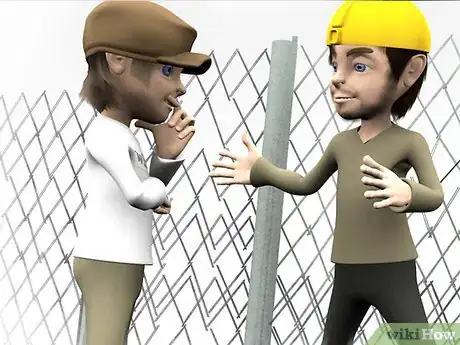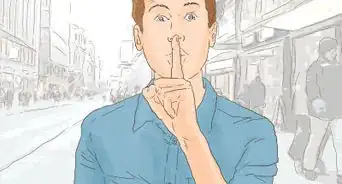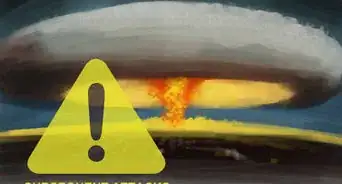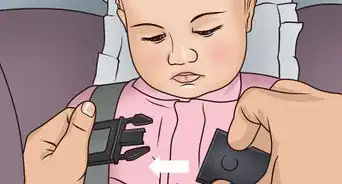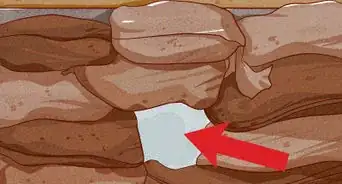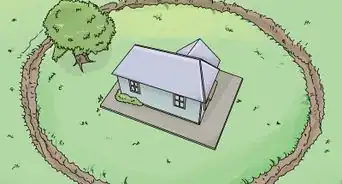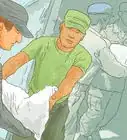wikiHow is a “wiki,” similar to Wikipedia, which means that many of our articles are co-written by multiple authors. To create this article, 44 people, some anonymous, worked to edit and improve it over time.
There are 9 references cited in this article, which can be found at the bottom of the page.
This article has been viewed 172,175 times.
Learn more...
Fields peppered with deadly mines in North Korea, Afghanistan, India, Vietnam, Iraq, and many other places are responsible for thousands of deaths every year. Even mines decades old are as dangerous as when they were first laid, capable of exploding at the slightest pressure. Read on to find out how to safely escape a minefield, and avoid entering one in the first place.
Steps
Scoping Out the Situation
-
1Look for signs that mines are close. Most mines are hidden, but if you know what to look for you'll have a better chance of avoiding them. Don't let your guard down, even for a moment, if you are in a mined area. Constantly be on the lookout for the following signs:
- Trip wires. These aren't usually clearly visible, so you've got to look closely at the ground. Wires are usually thin enough to be almost impossible to see.
- Signs of road repair. This includes paved areas, new fill, road patches, ditches, and so on. This could be a sign that mines were installed nearby.
- Signs or markers on trees, stakes, or posts. The forces that place the mines may mark the minefields to protect their own soldiers.
- Dead animals.[1]
Cattle and other animals frequently detonate mines.
- Damaged vehicles. Abandoned cars, trucks or other vehicles may have detonated a mine, and more could be close by.
- Suspicious objects in trees and bushes. Not all mines are buried, and not all UXO land on the ground.
- Disturbances in previous tire tracks or tracks that stop inexplicably.
- Wires leading away from the side of the road. They may be firing wires that are partially buried.
- Odd features in the ground or patterns that are not present in nature.[2]
Plant growth may wilt or change color, rain may wash away some of the cover, the cover may sink or crack around the edges, or the material covering the mines may look like mounds of dirt.
- Civilians staying away from certain places or out of certain buildings.[3]
Locals often know where mines or unexploded ordnance (UXO) are located. Question civilians to determine the exact locations.
- Trip wires. These aren't usually clearly visible, so you've got to look closely at the ground. Wires are usually thin enough to be almost impossible to see.
-
2Stop immediately.[4] The moment you realize you may be in danger, freeze. Do not take another step. Take some time to assess your situation and formulate an escape plan. Your movements from now on need to be slow, careful and considered.Advertisement
-
3Call out a warning to companions. As soon as you think you are in danger, make sure everyone knows so they can stop moving before someone detonates an explosive. Yell, "freeze!" and tell them to not to move their feet. If you're the leader in this situation, you'll have to coach them on how to leave the field safely; make sure everyone's on the same page, because one wrong move could get everyone killed.
-
4Do not pick anything up. Many mines are booby-trapped.[5] You think you're picking up a helmet, radio, or military artifact, and lo and behold, there's a mine inside. Even toys and food are used as bait. If you didn't drop it, don't pick it up.
Getting Out Safely
-
1Backtrack your way out of a mined area. Should you suspect that you have entered a minefield or mined area, either because you see warning signs, you see a mine or potential mine, or because a detonation occurs, remain calm and carefully back out of danger by stepping in your footsteps. If possible, do not turn around.
- Look behind you as you walk, and slowly place your feet exactly where they were before.
- Continue until you are sure you are out of danger, such as when you reach a road or other frequently traveled area.
- Look behind you as you walk, and slowly place your feet exactly where they were before.
-
2Probe the ground. If you have to move forward for some reason, or you can't see your tracks to backtrack, you'll need to probe the ground for mines and move forward little by little. Probe the ground very carefully with your hands or feet; you can also use a knife or another object to gently probe the area inch by inch.
- Probe at an angle, rather than straight down, since mines are usually detonated from top-down pressure.[6]
- Once you've cleared a small area, move forward and continue probing. It's safest to move through the field very slowly and on your belly, rather than walking through.
- Probe at an angle, rather than straight down, since mines are usually detonated from top-down pressure.[6]
-
3Get help if you're in over your head. If you're not absolutely sure where you stepped before, and you don't feel comfortable probing, don't risk moving. Inches can be the difference between life and death. Call for help or have people nearby do so.[7]
- If you are alone and can use a cell phone, call for help.
- Do not use two-way radios unless absolutely necessary. The signal from the radio may cause certain types of mines or UXO to accidentally detonate.[8]
- If you have no way of reaching anyone, wait. Do not try to "make a run for it" and do not attempt to probe your way out unless you know what you are doing.
- If you are alone and can use a cell phone, call for help.
-
4Pay attention for signs that a detonation may occur. When exiting a minefield be alert for signs that a mine may detonate. Listen for unusual noises. You may notice a faint click if a pressure plate has been depressed or a tilt rod has been moved, or, more likely, you may hear the pop of the exploding cap. Pay attention to what you can feel, as well. If you are very alert and proceed slowly you may be able to feel the tension of a trip wire, for example.
-
5Drop to the ground immediately if a detonation has been initiated.[9] Soldiers call this "hitting the deck." If you notice any of the signs from the last step, or if someone nearby cries out a warning that they have detonated a mine, drop to the ground as quickly as possible. You may have as little as a second before the mine explodes, but if you use that second wisely you may be able to escape serious injury or death. Mines explode upward, and it's safest close to the ground.
- If possible, fall backward in order to shield your upper body from shrapnel as much as possible. While it's certainly possible to fall onto another mine, the area right behind you is the safest place to fall, because you were just walking there.
- Do not try to outrun the explosion; projectiles will fly out from the mine at thousands of feet per second, and the casualty radius - the distance from the mine in which you can expect to be injured - can be up to 100 feet or more.
- If possible, fall backward in order to shield your upper body from shrapnel as much as possible. While it's certainly possible to fall onto another mine, the area right behind you is the safest place to fall, because you were just walking there.
-
6Mark the hazard, and report its location to the proper authorities. If you find a mine, help make sure that other people avoid it by marking it.[10] Use internationally recognized symbols or signs if possible, or use the customary local warning. Make sure you are in safe territory before attempting to erect a warning. Note the location of the danger, and report it to police, the military, or local de-miners.
Avoiding Minefields
-
1Learn about land mines. Unexploded ordnance (UXO) is a term used to denote any kind of explosive weapons, such as bombs, grenades, and artillery shells, that have been used but have not yet exploded - "duds," in other words - and that retain the potential to detonate.[11] Landmines are sometimes considered a type of UXO, and while mines receive the most media attention, all UXOs are dangerous. In some parts of the world, UXO other than mines present the greatest hazard.
-
2Learn about the history of an area. Anytime that you are traveling to an unfamiliar area, it's wise to learn about the history of that area to determine if there is a landmine risk. Areas that are experiencing armed conflict are clearly high-risk, but landmines and UXOs remain dangerous long after the cessation of hostilities.
- In Vietnam, Cambodia, and Laos, for example, millions of mines and dud bombs remain, and even in Belgium, long combat-free, crews have removed hundreds of tons of UXO, left over from WWI and WWII, in the past few years.
-
3Heed warning signs. While you can't always count on minefields being marked, you should definitely stay away from those that are. Internationally recognized symbols for minefields include a skull-and-crossbones and a red triangle. Signs are often, but not always, red, and they frequently say "MINES" or "DANGER."[12]
- Where signs are not present, improvised warnings are often used, such as painted rocks (red usually indicates the boundary of the minefield, and white indicates a safe path through it), piles of stones, flags in the ground, tied grass, or ribbons cordoning off an area.
- Many minefields have no warning signs, so don't take the lack of a warning sign as an indication that the area is safe.[13]
- Where signs are not present, improvised warnings are often used, such as painted rocks (red usually indicates the boundary of the minefield, and white indicates a safe path through it), piles of stones, flags in the ground, tied grass, or ribbons cordoning off an area.
-
4Inquire locally. Mine warnings often don't last long. Over time, plants, weather, animals and people dismantle or conceal signs. In some areas, metal signs are a valuable building material, and it's not uncommon to see a mine warning used, for example, to patch a metal roof. What's more, in many places, warnings are never installed. Local people, however, often know the general locations of mines and UXO, so your best bet when traveling in potentially dangerous territory is to ask the locals whether an area is safe, or better yet, get a guide.
-
5Don't stray off established paths. Except in active combat situations, if people regularly use a path, you can be sure it is not mined. Just off the path, however, danger may be lurking.
Community Q&A
-
QuestionDo mines explode if I get too close to a dead animal and/or abandoned vehicle?
 KennyCommunity AnswerYou shouldn't get anywhere near anything you aren't familiar with if you are in a minefield. As previously stated, there is a chance that random items are actually booby traps. Proximity mines do not exist; modern mines and ones made before today only explode upon contact.
KennyCommunity AnswerYou shouldn't get anywhere near anything you aren't familiar with if you are in a minefield. As previously stated, there is a chance that random items are actually booby traps. Proximity mines do not exist; modern mines and ones made before today only explode upon contact. -
QuestionIs it possible to see trip wire if they have dew drops on them?
 Community AnswerTrip wires are designed to be camouflaged by color, so if you are in a grassy area the, wire is green; if you are in the desert, the trip wires are tan. You may be able to see dew drops on the trip wires if the sun hits them and makes them shine. Also, if the mine has a pressure release detonator, it has to be pulled tight and you may be able to see them then.
Community AnswerTrip wires are designed to be camouflaged by color, so if you are in a grassy area the, wire is green; if you are in the desert, the trip wires are tan. You may be able to see dew drops on the trip wires if the sun hits them and makes them shine. Also, if the mine has a pressure release detonator, it has to be pulled tight and you may be able to see them then. -
QuestionWhat breed of dogs do they use to sniff out landmines in minefields?
 KennyCommunity AnswerMost dogs that have great senses of smell can be trained to become mine detecting dogs. Mine detecting is a skill developed over time for dogs, not one that occurs naturally in specific breeds.
KennyCommunity AnswerMost dogs that have great senses of smell can be trained to become mine detecting dogs. Mine detecting is a skill developed over time for dogs, not one that occurs naturally in specific breeds.
Warnings
- Remember that mines do not work like in the movies - you won't hear a 'click' or generally have any warning before the mine is activated. You cannot outrun a mine, particularly a bounding mine that uses a primary charge to lift the mine out of the ground, before detonating a secondary charge that scatters metal balls or shrapnel in all directions. These pieces can be expected to travel faster than a rifle round and may go in any direction.⧼thumbs_response⧽
- Make sure not to drop anything or drag anything along the ground while you are backtracking.⧼thumbs_response⧽
- Do not tamper with mines or UXO, and do not attempt to destroy them unless you are properly trained and equipped.⧼thumbs_response⧽
- Unless you are a trained and properly-equipped de-miner, you should always obey "do not enter minefield" signs posted, if any.⧼thumbs_response⧽
- Never assume a recently "cleared" area is safe. Mine removal is a difficult and tricky process, and it's not unusual for landmines to remain in an area that has officially been cleared. One of the primary reasons for this is that mines that have been in the ground for a long time may sink substantially. In the course of the yearly freeze-thaw cycle, however, frost heaves sometimes push these deeply buried mines to the surface.⧼thumbs_response⧽
- Do not use two-way radios when you are in a minefield. The signal from the radio may cause certain types of mines or UXO to accidentally detonate. If others are in a minefield, get at least 300 meters away before attempting to radio for help. The signal from cell phones may also have the capability to accidentally detonate explosive devices (insurgents and terrorists have frequently used cell phones to remotely detonate explosive devices, but these detonations required a signal).⧼thumbs_response⧽
- Don't throw rocks at, or attempt to shoot a mine or UXO. If other mines are present, the detonation of one mine may set off a chain reaction of detonations.⧼thumbs_response⧽
References
- ↑ http://studioissa.com/warning-signs-how-landmines-can-teach-us-about-project-design-and-communication/
- ↑ http://studioissa.com/warning-signs-how-landmines-can-teach-us-about-project-design-and-communication/
- ↑ https://www.quora.com/How-can-you-know-that-you-entered-a-mine-field-if-there-aren-t-any-signs
- ↑ https://www.wearethemighty.com/articles/how-to-escape-a-minefield
- ↑ https://www.care.org/emergencies/facts-about-landmines
- ↑ https://www.care.org/emergencies/facts-about-landmines
- ↑ http://www.ipsnews.net/2009/11/qa-if-you-find-yourself-in-a-minefield-shout-for-help/
- ↑ https://www.wearethemighty.com/articles/how-to-escape-a-minefield
- ↑ https://www.businessinsider.com/two-simple-rules-to-survive-a-bomb-blast-2013-4
- ↑ http://www.ipsnews.net/2009/11/qa-if-you-find-yourself-in-a-minefield-shout-for-help/
- ↑ http://www.defence.gov.au/UXO/What/
- ↑ http://studioissa.com/warning-signs-how-landmines-can-teach-us-about-project-design-and-communication/
- ↑ https://www.care.org/emergencies/facts-about-landmines
- GlobalSecurity.org U.S. Army Field Manual 20-32: Mine/Countermine Operations
- U.S. Army Field Manual
About This Article
Minefields are dangerous and hard to navigate, but with some careful scoping, it’ll be easier for you to escape. The moment you realize you’re in a minefield, stop and don’t take another step until you’ve come up with a plan for escape. If you’re able to, slowly backtrack the exact path you came from, since this is the safest route. Or, probe the ground for mines by very gently testing the ground with your hands or feet before taking a step. If you find any wires coming from the side of the road or mounds of dirt, these may be mines. As you exit the minefield, try to be as quiet as you can and listen for detonation noises. If you hear a faint click or pop, a mine is probably exploding and you should drop to the ground to protect yourself. To learn how to recognize the signs of a minefield, read on!
